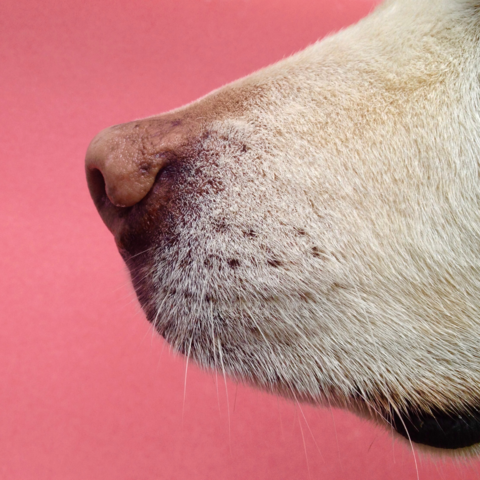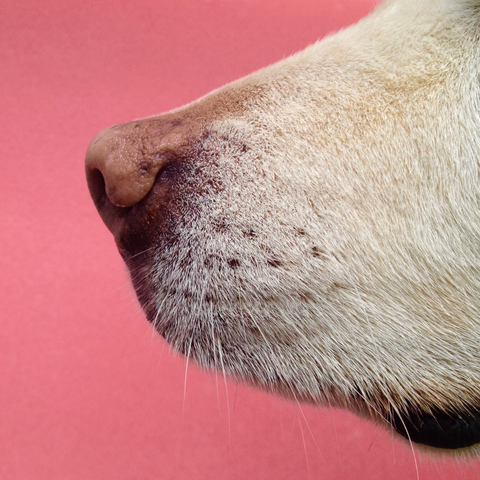
The Why on Whiskers
Share
Ever wonder about the "why" behind your pet's whiskers? Check out the information to learn more about your pet's whiskers.

What are Whiskers? What are they for?
Even though whiskers erupt from hair follicles like other hairs, they really stand out on a dog’s body. Whiskers are coarser and thicker than regular hair and have roots that are three times deeper. Unlike regular hairs, whiskers don’t cover the entire body. They are strategically located above the eyes, on the chin, and above the upper lip. The exact pattern and location of whiskers varies with breed. Unlike humans, dogs of all ages have whiskers. Newborn pups don’t need to reach puberty before growing whiskers, which are among the first hairs to develop and are present at birth. Whiskers are more sensitive than regular hairs because the follicles from which they originate are packed with blood vessels and nerves. In fact, a dog’s whiskers are as sensitive as a human’s fingertips. So, while human’s sense of touch is in the fingers, a dog explores and touches the world with his face!
A dog’s face is accentuated by his whiskers. They frame the eyes sort of like eyebrows and emphasize the muzzle when a dog “smiles.” But whiskers are more than just facial enhancements; they serve an important function. Whiskers are specifically tuned sensory equipment that guide a dog through daily activities. These specialized hairs aid vision and help a dog navigate his environment by providing additional sensory input much like antennae on insects.
Although whiskers are called “tactile hairs,” they don’t actually feel anything. They simply transmit information to sensory cells when they detect objects or movement. When air flows over, or an object brushes up against a whisker, the sensitive hair vibrates and stimulates the nerves in the hair follicle. This vibration gives whiskers their scientific name vibrissae, from the Latin word vibrio meaning “to vibrate.” Detecting subtle changes in air currents, dog whiskers transmit information about the size, shape, and speed of nearby objects, which helps dogs navigate the world.
They are quite different from most other hairs on the dog’s body. To begin with, they are considerably more rigid and embedded more deeply into the skin. Much more important, however, is the fact that at the base of each vibrissa is a high concentration of touch-sensitive neurons so that the slightest pressure on that stiff hair will produce a neural response.
The vibrissae serve as an early warning device that something is near the face and thus helps the dog prevent colliding with walls or objects and alerts the dog that something is approaching which might damage his face or eyes. You can demonstrate this for yourself by tapping gently on the vibrissae of a dog. With each tap, the eye on the same side of the face will blink protectively, and the dog will tend to turn his head away from the side tapped.
Whiskers = Radar Sensors
Dogs are known for their great senses of smell and hearing, but canine vision is not so wonderful. Dogs see better at a distance but have difficulty focusing on objects up close, so whiskers help them “see” things that lie right under their noses by constantly sending information to the canine brain. As a dog approaches something in his path, he stirs up air currents that bounce back when they hit solid objects. Whiskers detect very faint vibrations caused by these changes in air currents and act like radar detectors.
"Whiskers detect very faint vibrations
caused by changes in air currents
and act like radar detectors."
In the wild, whiskers can alert a dog to the presence of prey, potential enemies, or the location of his pack. At home, whiskers, help domestic dogs locate their food bowls or favorite toys at night. In other words, whisker radar can help a dog hunt at night as well as prevent him from bumping into walls in the dark.
Whiskers Communicate Emotions
When a dog is resting, the whiskers take a break. But when a dog is active, so are they! A happy or curious dog will elevate the whiskers above his eyes giving him that cute, wide-eyed appearance we love. If a dog feels threatened, he will flair the whiskers on his muzzle and direct them forward toward the threat.
Whiskers Protect & Need Protection
These sensitive hairs respond when touched by the smallest particles. When a tiny speck of dust falls on a whisker above his eye, a dog will blink or shake his head and fling it off. This reaction protects the eye which can be injured by even a tiny dust particle. When walking outside, if the whiskers on a dog’s muzzle encounter a tall blade of grass or a thorny bush, they prompt the dog to back up to avoid being scratched or poked in the eye.
Whiskers also prevent dogs from getting into jams. As a dog approaches a narrow spot in the fence or a slender space between rocks or a small area between the living room chairs, whiskers help him determine if he can fit through the passage without getting stuck or turning over the furniture. This keeps the dog out of trouble in more ways than one!
A good portion of the dog’s brain is devoted to processing data from touch sensors. Whiskers are very reliable touch sensors so almost 40% of the brain’s sensory area aligns with parts of the body that have whiskers. Each individual whisker can be traced back to a specific spot in the brain which means that whiskers occupy valuable neurological real estate in a dog’s body.
Because whiskers are so important to a dog’s ability to safely function inside and outside, we need to protect them. When petting your dog, touch the whiskers very gently along the grain. Don’t pluck or pull on the whiskers which will be painful for your pup. When grooming your dog, avoid cutting the whiskers, because this may decrease his special awareness and confuse him.

Never Cut or Remove Whiskers!
Dogs whose vibrissae have been removed seem more uncertain in dim light. Under these conditions they actually move more slowly because they are not getting the information that they depend upon to tell them where things are that they might bump into.
With intact vibrissae, the dog actually does not have to make physical contact with a surface to know it is there. These special hairs are so sensitive that they also register slight changes in air currents. As a dog approaches an object like a wall, some of the air that he stirs up by moving bounces back from surfaces, bending the vibrissae slightly. The resulting neural response is enough to inform him that something is near well before he touches it.
Next time you take your dog to the groomer, be sure to tell them to leave your dog's whiskers alone.
If your dog’s whiskers are cut off, it can interfere with their ability to navigate their surroundings. Your dog may run into more items and be more susceptible to getting injured. The removal of a dog’s whiskers can be uncomfortable and stressful for them.
Yes, dog whiskers can grow back if cut or if they fall out. The hair growth rate varies, and there is no exact timeline.
NEVER pull on, tug, rip, or cut your pets whiskers. It can be very uncomfortable for them, cause pain, and cause them to become disoriented.
Sources:
www.NaturesSelectShop.com
